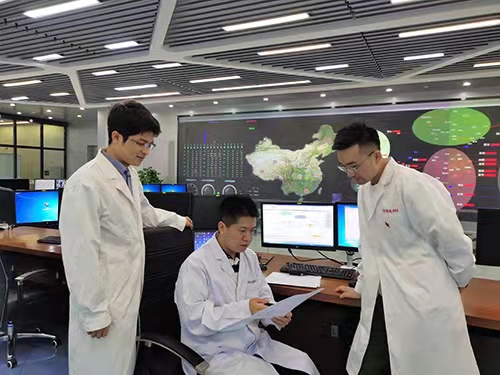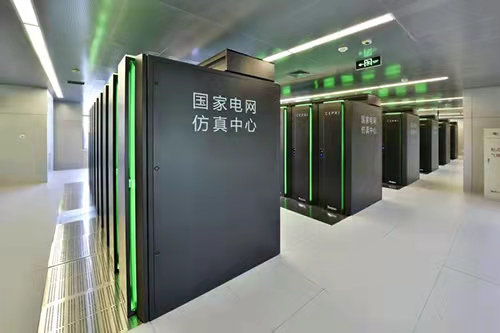from:China Electricity Councildate:2022-05-02
It has recently attracted wide attention that the wind and solar power from Zhangjiakou were transmitted to the venues of the Beijing Winter Olympics through Zhangbei VSC-HVDC Project, achieving 100% green power for all venues for the first time in the history of the Olympic Games. But what is less known is that the whole process of planning, construction and operation of the Zhangbei VSC-HVDC Project, with the highest voltage level and the largest transmission capacity of its kind in the world, is indispensable to the strong support of the power grid simulation technology.
At the State Grid Simulation Center of China Electric Power Research Institute (CEPRI), the more accurate and efficient electromagnetic transient (EMT) simulation technology are playing an increasingly important role in construction and operation of power grids, grid-connection support of new energy, and building of new power systems.
The unprecedented large-scale and high-complexity of power grids stimulates the simulation technology to keep on upgrading
The Zhangbei VSC-HVDC Project is a major technological trial demonstration project that combines friendly grid-connection of large-scale renewable energy, mutual complementation and flexible consumption among multiple forms of energy, and construction of DC power grids. In the absence of experience to learn from, the high-precision simulation is indispensable in the process of research, development, test commissioning, and grid-connection. "We have conducted more than 80,000 simulation computing under 5,800 working conditions for the Zhangbei VSC-HVDC Project and carried out all-around simulation analysis and experimental verification in terms of the project's grid-connection characteristics, operation mode arrangements, control and protection strategies, and troubleshooting measures. As a result, the project was successfully put into operation and supplied green electricity for the Beijing Winter Olympics," said Zhu Yiying, Director of the Digital-Analog Hybrid Simulation Research Office of State Grid Simulation Center.
As we all know, the power system is the most complex man-made dynamic system in the world and is the cornerstone for the functioning of modern society. As compared to systems such as highway and railway transportation, natural gas, water conservancy, and oil, it has the characteristics such as electric energy transmission at speed of light, real-time balance in the whole process from generation to consumption, and uninterruptability. Therefore, it demands extremely high safety and reliability. Simulation is not only a major means to learn about the characteristics of power grids, analyze planning schemes, work out control strategies, and verify precautions, but also a critical core technology in the power system. With the continuous increase of power systems in size and complexity, simulation technology has to keep on upgrading to meet the needs of the development of power systems.

CEPRI research team is doing scientific research at State Grid Simulation Center.
“Older power system simulation technology including electromechanical transient simulation has provided strong support to the high-quality and rapid development of China’s power grids in the past decades. In recent years, as China speeds up energy transition and makes great strides in DC transmission and new energy, China’s power grids have gradually become a modern power system with a large number of power electronic equipment and cross-regional hybrid AC-DC interconnections. The size and complexity of the grids are unprecedented, with great changes in structural morphology and technical foundation of the power system. Consequently, the existing simulation technology no longer meets the needs of the fast-developing power grids and faces the problems of ‘unable, inaccurate, and slow simulations’. It is therefore imperative to develop a more accurate and efficient simulation technology and build a new-generation simulation platform that supports the power systems with high-proportion of new energies,” said He Jingbo, Division Chief of System of National Power Dispatching and Control Center.
According to information, the new-generation simulation platform passed the acceptance of the expert group on December 26, 2017 and became an important technical means for comprehensively improving the understanding, analysis, and control of complex power systems. It has since been widely used for analytic computing and experimental research in planning of China's power grids, decision-making in dispatching and operation, as well as development of new equipment.
Master the core EMT simulation technology to continuously improve the safety of large power grids
It’s known that in the development of traditional AC power grids, the electromechanical transient simulation is mostly used at home and abroad in researches for the safety and stability of large power grids to support the safe operation of real-world power grids. However, with extensive DC transmission and new energy connected to grids, new safety problems come forth. The power grid blackouts in the United Kingdom and Australia indicate that the interaction between power electronic equipment and AC power grids involves complex dynamic processes and has chain reaction risks, and it may easily result in large-scale blackout. The electromechanical transient simulation is mainly used to simulate the slow-motion process of the alternator rotor, but it cannot accurately simulate the characteristics of fast response and control of power electronic devices. Therefore, the more accurate EMT simulation become essential.
“EMT simulation is a high-precision simulation technology. Using EMT to compute the simulation of large-scale power grids is like building a skyscraper with nanometre-level structural accuracy, so the difficulty is hard to imagine. Many industry experts consider it a world-class technical issue impossible to tackle. However, since China’s power system has already been world-leading, tackling such issue is what we have to take on,” said He Jingbo. To this end, in developing the new-generation simulation platform, State Grid Simulation Center has solved the technical problems such as model algorithm, numerical stability, computing technology, and platform architecture. In doing so, the simulation time of large power grids has been reduced from milliseconds to microseconds. We have successfully realized the EMT simulation of large-scale power grids connected with multiple DC circuits and high-proportion of new energy and applied it in China’s ultra-large-scale power grid projects. The simulation scale of this technology includes as many as ten thousand nodes, and the boot time of the electromagnetic model is reduced from hundreds of seconds to less than 5 seconds. This means that the computing efficiency is increased by more than 3,000 times and various technical indicators are leading the world.
It is understood that the core equipment, technologies, and software of the new-generation simulation platform have been fully localized. Up to now, in addition to the above-mentioned Zhangbei VSC-HVDC Project, the achievements of the platform have also played an important role in the development and operation practices of the power grids such as West-to-East Power Transmission, regional power grid interconnection, UHV AC and DC transmission projects, and centralized new energy transmission. These achievements have also been used in all provincial companies affiliated to State Grid, which ensures the further improvement of the power transmission capacity and safe operation of China’s power grids, and generates economic benefits of more than CNY 12 billion.
Additionally, these achievements have been applied in dozens of organizations in China including China Southern Power Grid, and promoted to power grid projects in Brazil, Pakistan and other countries.
Help build a new power system with more grid-connected new energy
For more than a decade since 2009, State Grid has completed 15 AC and 14 DC UHV transmission projects. By the end of 2021, State Grid achieved that the installed capacity of new energy connected to grid reached 536 GW, making it the most complex and the largest grid in the world in terms of installed capacity of new energy integration.
To meet the goals of carbon peaking and carbon neutrality, China proposed to build a new power system which allows high-proportion of new energy to get connected to the grid. The more obvious “double high” (high proportion of new energy and high power electronic equipment) characteristics and the sharp increase of nodes and complex control components in the power system, as well as the continuous construction of UHV AC and DC projects, make it more complicated to ensure the safe operation of large power grids. All these have set higher requirements for the capability, accuracy, and efficiency of simulation computing.

Supercomputing Center of State Grid Simulation Center, CEPRI
According to He Jingbo, at present, the technology, equipment, and algorithms of the new-generation simulation platform can meet the needs of new power system for simulation computing in its planning, construction and operation, and provide strong fundamental technical support for accelerating China’s energy transition. At the same time, State Grid Simulation Center will further summarize and analyze the power grid simulation methods, apply new technologies and new equipment such as big data and artificial intelligence (AI), and optimize the effective and accurate computing theories and methods which adapt to the new form of power system. It will further boost the role of simulation technology in scientific planning of power grids, increasing the proportion of grid-connected new energy, improving the operation efficiency of the power system, and improving the safety and stability of power grids.
Tel:+86-25-84152563
Fax:+86-25-52146294
Email:export@hbtianrui.com
Address:Head Office: No.8 Chuangye Avenue, Economic Development Zone, Tianmen City, Hubei Province, China (Zip Code: 431700) Nanjing Office: Building 23, Baijiahu Science and Technology Industrial Park, No.2 Qingshuiting West Road, Jiangning Economic Development Zone, Nanjing City, Jiangsu Province,China (Zip Code:211106)
